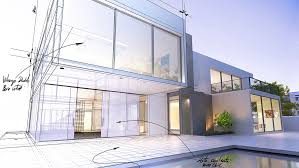The Role of CAD in Architecture
Computer-Aided Design (CAD) has revolutionized the field of architecture, providing architects and designers with powerful tools to create precise and detailed architectural drawings. CAD software allows professionals to draft, model, and visualize building designs in a digital environment, streamlining the design process and enhancing efficiency.
One of the key benefits of CAD in architecture is its ability to create accurate and intricate 2D and 3D models of buildings. Architects can easily manipulate these models to experiment with different design ideas, analyze spatial relationships, and simulate real-world conditions. CAD software also enables architects to generate construction drawings, floor plans, elevations, and sections with precision and consistency.
Furthermore, CAD facilitates collaboration among architects, engineers, contractors, and clients by providing a common platform for sharing design data and communicating ideas effectively. Changes can be made quickly and efficiently in a CAD environment, allowing for seamless coordination between project stakeholders throughout the design process.
Another advantage of using CAD in architecture is the ability to integrate sustainable design principles into building projects. Architects can use CAD software to optimize energy efficiency, daylighting, ventilation systems, and material selection to create environmentally friendly and sustainable buildings.
In addition to improving design accuracy and efficiency, CAD technology has also expanded the possibilities for architectural visualization. Architects can produce realistic renderings and walkthroughs of their designs to help clients better understand the spatial qualities and aesthetics of a proposed building.
In conclusion, CAD plays a vital role in modern architecture by empowering architects with advanced tools for designing innovative, sustainable, and visually compelling buildings. As technology continues to evolve, CAD will undoubtedly continue to shape the future of architectural practice.
Top 4 Frequently Asked Questions About CAD Architecture
- Is AutoCAD Architecture better than AutoCAD?
- What is CAD for architecture?
- What do architects do in CAD?
- Does AutoCAD Architecture still exist?
Is AutoCAD Architecture better than AutoCAD?
When comparing AutoCAD Architecture to AutoCAD, it ultimately depends on the specific needs and preferences of the user. AutoCAD Architecture is tailored specifically for architectural design tasks, offering specialized tools and features that cater to the unique requirements of architects and designers. It includes built-in architectural objects, styles, and workflows that streamline the design process for building projects. On the other hand, AutoCAD is a more general-purpose CAD software that can be used for a wide range of design and drafting tasks beyond architecture. While both programs are powerful tools in their own right, choosing between AutoCAD Architecture and AutoCAD should be based on the specific requirements of the project and the expertise of the user in utilizing each software effectively.
What is CAD for architecture?
CAD for architecture refers to the use of Computer-Aided Design software specifically tailored for architects and designers to create precise and detailed architectural drawings in a digital environment. CAD software enables architects to draft, model, and visualize building designs with accuracy and efficiency. It allows professionals to generate 2D and 3D models of buildings, produce construction drawings, explore design variations, analyze spatial relationships, and simulate real-world conditions. CAD for architecture streamlines the design process, enhances collaboration among project stakeholders, and facilitates the integration of sustainable design principles into building projects.
What do architects do in CAD?
In CAD architecture, architects utilize specialized software tools to create detailed and precise digital representations of building designs. Architects use CAD to draft floor plans, elevations, sections, and 3D models of structures, allowing them to visualize and refine their design concepts. CAD enables architects to experiment with different design options, analyze spatial relationships, and make adjustments efficiently. Additionally, architects use CAD to generate construction drawings, collaborate with project stakeholders, simulate real-world conditions, and integrate sustainable design principles into their projects. Overall, architects leverage CAD technology to streamline the design process, enhance accuracy, improve communication, and bring their architectural visions to life in a digital environment before construction begins.
Does AutoCAD Architecture still exist?
Yes, AutoCAD Architecture still exists as a specialized version of the popular AutoCAD software tailored specifically for architectural design and drafting tasks. AutoCAD Architecture offers a range of features and tools that cater to the unique needs of architects, allowing them to create detailed building designs, floor plans, elevations, sections, and construction drawings efficiently. With its comprehensive set of architectural tools and functionalities, AutoCAD Architecture remains a valuable software solution for architects seeking to streamline their design process and enhance productivity in the field of architecture.

